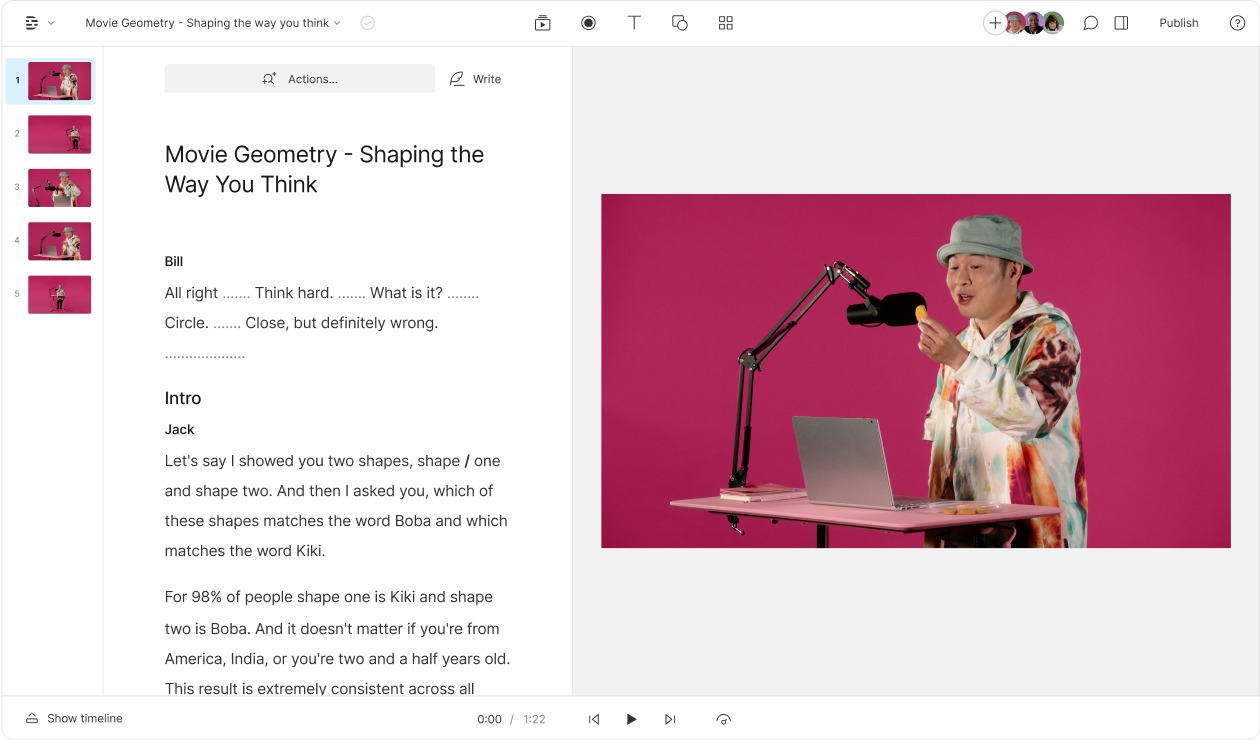What type of content do you primarily create?




Ever noticed how your social media feed is filled with videos playing silently with captions? There's a reason for that. Subtitles don't just make your content accessible—they're practically essential in a world where most people watch videos with the sound off. Plus, they boost your YouTube SEO and make your videos more accessible.
When it comes to adding subtitles, iMovie—Apple's budget-friendly video editor—gets the job done. It's probably already on your Mac, iPad, or iPhone, which is convenient. But convenient doesn't always mean efficient.
Here's the unvarnished truth about adding subtitles in iMovie: you'll need to manually type every single word. No automatic transcription. No SRT file imports. Just you, your keyboard, and potentially hours of painstaking work depending on your video length.
We'll also show you how tools like Descript, an advanced subtitle generator, can automate this process with features like automatic transcription and synchronized subtitling. Because while manually typing every subtitle has a certain charm, most of us prefer to spend our time on actual creative work.
Quick guide: How to add subtitles in iMovie
- Import your video clip into iMovie.
- Choose a subtitle style from Titles and position it on your video.
- Double-click the title box to type your subtitles and adjust their duration.
- Customize the subtitle appearance with font, size, and color options.
- Save the video by going to File > Share > File.
How to import SRT files into iMovie
iMovie doesn’t natively support SRT file imports, but you can still incorporate your subtitles with a few extra steps. One approach is using Rev.com or InqScribe to generate or edit your SRT files, then convert them into a plain-text format. You can also try specialized software like Subtitle Editor to export a text overlay that iMovie recognizes. Once you have your text-based subtitles, copy and paste them into iMovie’s Titles tool for manual timing adjustments. While these workarounds add a few extra steps, they let you preserve your carefully prepared subtitles inside iMovie’s otherwise limited environment.
Can you add subtitles in iMovie?
Yes, iMovie allows you to add subtitles and captions to your video projects manually. While iMovie doesn't directly accept caption files like .SRT, you can create subtitles and captions using the built-in title tools. This limitation remains consistent across all recent versions of iMovie as of 2025.
The process involves individually typing each subtitle or caption and syncing it with the corresponding video segment. If you have an external .SRT caption file, you'll need to open it in a separate window and copy-paste the captions one by one into iMovie's title editor. This manual method can be quite time-consuming compared to automatic subtitle generation tools.
Remember, you'll need to manually synchronize each caption with the video timeline to ensure accurate timing.
How to add subtitles in iMovie on Mac
1. Launch iMovie and create a new project or open your existing one.
 |
 |
2. Import your video clip by dragging it from the finder or using the Import Media button.
 |
3. Position the video clip on the timeline where you want the subtitles to appear.
 |
4. Click on the Titles button in the top toolbar.
 |
5. Choose a title style from the available options. You can preview them by hovering your mouse over each style. You can pick where you want the subtitles to appear—we recommend choosing one of the title options for the screen's bottom, such as lower, lower third, or reveal lower third.
 |
6. Drag and drop the chosen title onto the video clip in the timeline. This creates a title box.
 |
7. Double-click the title box to edit the text. Type your subtitles into the box.
8. Adjust the subtitle duration by dragging the edges of the title box in the timeline. You can also click the information icon (i) above the viewer and enter a specific duration.
 |
 |
9. Customize the subtitles by double-clicking the text box and then using the text editing options in the top right corner. You can change the font, font size, color, alignment, duration, etc.
 |
10. Repeat steps 4–9 for each subtitle you want to add.
11. Once finished, save your video by going to File > Share > File.
Or click the share icon in the top right corner. Click Export and choose the destination folder to save the video.
 |
How to add subtitles in iMovie on iPhone and iPad
- Launch iMovie on your iPhone or iPad.
- Choose the Start New Project option. Click Movie and then import the video or photos you need from your device.
- Tap a video clip or photo in the timeline to access the inspector at the bottom and make editing options appear.
- Tap the T (Titles) button at the bottom of the screen and select a title style.
- To remove titles, tap None.
- To reposition the title, tap and drag it to the desired location on the screen.
- To edit the title text, tap the sample title, then tap Edit and type your new title.
- To edit the subtitle duration, tap the title in the timeline and drag the edges of the title box where you need it.
- Tap Done on the keyboard once finished.
- Repeat steps 4–9 for each subtitle you want to add.
A video clip or photo with a title will have a T icon in the upper-left corner of the timeline.
Recognized accessibility standards for captions
Ensuring your subtitles meet widely accepted guidelines can make your content accessible to the largest possible audience. Following the WCAG 2.1 guidelines helps maintain a color contrast ratio that supports viewers with visual impairments. Aim for at least 4.5:1 for normal text and 7:1 for larger text. You should also keep your font size at least 24 pixels to ensure readability on multiple screens. By refining your caption design around these benchmarks, you can ensure your message is accessible without distracting from the video content.
Best practices for subtitles in iMovie
Want to ensure your captions or subtitles improve the viewer experience? Here are some best practices to follow:
Font and subtitle placement
- Functional trumps fancy. Opt for clean, easy-to-read fonts like Arial or Helvetica. Decorative or script-like styles can be challenging to understand, especially on smaller screens.
- Choose a font size large enough for viewers to read comfortably, considering where your video will be viewed (phone, computer, etc.).
- Leave adequate space between lines of text to prevent them from appearing cluttered and challenging to follow.
- Place captions or subtitles strategically on the screen so they don't obscure important visual elements (but remain easily visible).
Subtitle timing and synchronization
- Don't overload viewers with text in one go. Include concise phrases that allow viewers to read and absorb information without feeling overwhelmed
Subtitle accessibility
- Use high-contrast color combinations for the text and background so that viewers with visual impairments can easily read the captions.
- When there are multiple speakers, include speaker identification within the captions to help viewers understand who's saying what, especially in fast-paced dialogue.
Standardized subtitle formatting
- Proper capitalization, punctuation, and reading speed recommendations matter. Look for online resources or industry standards for specific formatting details.
- Adhere to standard conventions, like using brackets for sounds or side conversations within captions, so viewers effectively interpret non-verbal cues and context.
Limitations of subtitles in iMovie
While iMovie provides basic tools for adding subtitles and captions, it has several limitations:
- Creating subtitles in iMovie is time-consuming and labor-intensive, requiring manual typing or importing and synchronizing text files.
- You can't export subtitles as an SRT file to use them with another video captioning tool.
- iMovie lacks advanced captioning features such as automatic transcript generation or sophisticated caption formatting. This absence can make the process inefficient, especially for users working on professional-quality videos.
- iMovie does not support simultaneous collaboration, which can be a drawback for team projects.
- Relying on manual transcription or copying text from external text files leaves room for errors.
Descript: An alternative for adding subtitles in iMovie
While iMovie remains an intuitive tool for basic video editing, its subtitle and captioning capabilities may not meet the needs of all users, particularly those working on longer or more complex projects. The lack of SRT file import functionality and automatic subtitle generation continues to be a limitation in current versions of iMovie.
For a more efficient workflow, consider using an automatic subtitle generator app like Descript, which offers auto-synchronization and subtitle import features. In addition to its captioning and subtitling capabilities, Descript is also a powerful audio and video editor that simplifies the entire process of adding captions or subtitles to iMovie projects.
Try Descript for free now.
Here's a complete lowdown on why Descript is the best iMovie alternative for adding subtitles to your videos:
1. Automatic, AI-powered subtitle transcriptions
Descript boasts AI-powered transcription that automatically converts your video's speech to text. Also, the tool's automatic speaker detection feature differentiates between voices, making editing even smoother. It takes the grunt work out of caption and subtitle creation, saving you hours compared to manually typing everything in iMovie on Mac or iPhone.
2. Automatic subtitle syncing
Forget meticulously dragging and dropping text on your timeline in iMovie. Descript's subtitles generator syncs captions automatically to your video. Simply edit the text transcript directly, correct any mistakes, or remove filler words like 'um' or 'like', and the changes will be reflected in your video. If you encounter subtitle sync issues, you can easily adjust timing without starting over.
3. One-click subtitle translation
Descript allows you to translate video and subtitles into 20+ languages with a single click, breaking down barriers and expanding your viewership while eliminating the need for third-party translation apps and services.
 |
4. Collaborative subtitle editing across platforms
Working with your team is easy in Descript. Its collaborative editing features allow multiple users to work on captions simultaneously, making it ideal for group projects. The tool's cross-platform compatibility—on Mac, PC, and web—ensures seamless access across devices (not just the Apple ecosystem, like iMovie).
5. Effortless subtitle exports
Unlike iMovie, Descript allows you to export your captions as separate files in popular formats like SRT and VTT, giving you the flexibility to use your captions beyond just the Descript platform. This is particularly useful if you have SRT files that you want to use with your iMovie projects, as you can edit them in Descript first.
How to add subtitles to videos using Descript
You can add subtitles to your videos in three simple steps using Descript.
- Automatically transcribe your video
Import your video file into Descript by dropping it into a new project or uploading it via a YouTube or GIPHY video link.
 |
Descript will automatically transcribe your audio into text in the language of your choice and assign a speaker label to each voice.
 |
2. Add subtitles or captions
Correct any errors in the auto-generated transcript using Correct mode (press C), or use the Remove filler words action to remove repetition and words like "um" or "like".
 |
If you want to add embedded subtitles to your video, click Captions and choose a style or template.
 |
Your captions are automatically synced with the audio. Customize the font, colors, and style for your captions, or find ready-made Templates under the Captions and Audiograms categories.
Here's a quick video walkthrough:
3. Embed captions or download subtitle file
Preview your video to verify if the subtitles are correctly timed. Click Publish to export your subtitled video.
 |
You can even download a standalone subtitle file in SRT or VTT for your video.
 |
By streamlining the process and offering additional functionalities, Descript empowers creators of all levels to produce professional-looking content that resonates with a global audience.
How subtitles improve your video's reach
While subtitles open your content to a broader audience, creating them can be time-consuming and boring. If iMovie's manual captioning process feels limiting, you can check more efficient alternatives like Descript (that's us). The lack of automatic subtitle generation in iMovie is a significant drawback that makes the process much more labor-intensive.
In addition to automatically captioning your video, our AI-powered tool offers a wide range of audio and video editing features, making it ideal for podcasting, screen recording, and overall video production. While subtitles and captions help you reach a global audience, Descript empowers you to do even more.
With Descript, you can:
- Edit videos as easily as editing text
- Repurpose content for social media in minutes
- Share seamlessly on YouTube, Instagram, and TikTok
- Generate scripts, titles, and descriptions automatically
You can also use the tool to:
Descript's AI-powered editing assistant, Underlord, simplifies the process significantly compared to iMovie. It handles the details so you can focus on the big picture—making waves, getting noticed, and elevating your content.
Ready to elevate your video production?
Try Descript for free now and experience the future of video editing.
FAQs: How to add subtitles in iMovie
How can I add subtitles in iMovie?
You can add subtitles to your video using Descript as follows:
- Create a free Descript account.
- Import your video into a new Descript project, or upload it using a link (YouTube, GIPHY).
- Descript automatically transcribes your video's audio, identifying different speakers for easy editing later.
- Review the transcript and make any corrections with Correction mode (press C) or Remove filler words.
- Go to Underlord > Captions and choose a pre-made subtitle style or customize the font, color, and more to match your video's look.
- Preview your video to ensure perfect subtitle timing. Descript lets you embed subtitles directly into your video or download them as a separate SRT or VTT file for future use.
How do you add text subtitles in iMovie?
- Open your project in iMovie on Mac and drag the clip where you want to add text to the timeline.
- Click on the Titles button in the menu at the top of the screen and choose a style.
- Drag and drop the chosen title onto the video clip in the timeline to create a title box.
- Double-click the title box to type your desired text.
- Adjust the edges of the title box in the timeline to fix the duration. Or click the information icon (i) above the viewer and enter a specific duration.
- Customize the text using the text editing options in the top right corner.
- Repeat steps 3–6 for each piece of text you want to add.
- Save/export your video by going to File > Share > File.
How do I add subtitles in iMovie on Mac?
You can add subtitles to a video on your Mac using Mac's built-in video editor, iMovie. The process is the same as described above, but remember that adding background subtitles requires selecting a title style that includes a background or adjusting the opacity settings in the title editor.
- Import your video clip into iMovie.
- Choose a subtitle style from Titles and position it on your video.
- Double-click the title box to type your subtitles and adjust their duration.
- Customize the subtitle appearance with font, size, and color options.
- Save the video by going to File > Share > File.
How do I add subtitles in iMovie on iPhone?
To add subtitles to a video on an iPhone using iMovie, follow these steps:
- Download and open the iMovie app on your iPhone.
- Tap Start New Project > Movie to import the video to which you want to add subtitles.
- Once the video is imported, tap on it in the timeline to make editing options appear.
- Use the T (Titles) option to input the subtitle text that matches the video content.
- Set the right placement and duration for each subtitle by dragging it to the desired location on the timeline and adjusting the edges of the title box.
- Repeat the process for each subtitle you want to add to the video.
Can I import SRT files directly into iMovie?
No, iMovie does not support direct importing of SRT files. According to the research, you'll need to convert your SRT into a text-based format or manually copy and paste each line into iMovie’s Titles. Tools like Rev.com or InqScribe can help you manage and export your subtitles in a way that partially automates the process. This extra step ensures accurate on-screen text, but it will still take some time to finalize within iMovie.
How do I sync subtitles with the audio in iMovie?
To align subtitles precisely, move each text overlay within iMovie’s timeline so that it starts and ends in sync with the spoken words. The content gap research suggests using the Adjust tab to fine-tune the position and duration of each subtitle. After placing all your text overlays, preview the project to catch any timing inconsistencies. If you see any text lag, simply drag the edges of the overlay until it lines up perfectly with the audio.





























%201.svg)









